meteorological and astronomical codes telegraphic codes, main
This page concerns what might be called observational codes, that is, those designed for descriptions of ephemeral conditions — the weather, ice conditions — and those for descriptions of less ephemeral matters, e.g., fingerprint and other police codes, and even epidemiological codes. But those others have their own page(s).
upper vertical bar ╹ at left returns to top of page; lower ╻ goes to main telegraphic codes and message practice page.
meteorological codes —
1872 Cipher used for the telegraphic transmission of the weather reports (Signal Service, US Army)
1896 Weather Code (USDA)
1930 International radio weather code for use on United States selected ships (USDA)
1939 Weather Code (Numeral System, USDA)
2012 Standard Hydrologic Exchange Format (SHEF, NWS/NOAA)
telegraphy in meteorology (contemporary and historical accounts)
astronomical codes —
1888 The Science Observer Code (astronomy)
1906 Telegraphic Cipher Code, Gerrish System (astronomy)
1936 to present (codes and accounts of astronomical telegrams)
![]()
meteorological codes : an introduction
It was evidently possible to study with advantage, the progress of atmospheric changes only when the telegraph lines had become widely extended over the earth’s surface.
— Cleveland Abbe, Historical Notes on the Systems of Weather Telegraphy, and especially their Development in the United States.
American Journal of Science and Arts, 3rd. ser. 2 (1871) : 81-88
Meteorology developed in the nineteenth century on the back of telegraph and cable networks, by which widely scattered stations could submit their observations to a central point. Those "synoptic weather observations" were — and are today — made periodically, e.g., 8:00 am and 8:00 pm, and cover data on sky cover, state of the sky, cloud height and description, maximum and minimum temperatures, wind speed and direction, special conditions, &c. It is hard to imagine meteorology and weather prediction in the absence of the intelligence exchanged over telegraph networks.
Aeronautics was a second factor that pushed meteorology in new directions — mainly up; in so doing, aeronautics also vastly increased the need for observational data. Conventional land-based observations and their telegraphed transmissions weren't up to the new requirements; telegraphy, it was charged, imposed restrictions on the number of observations that could be transmitted, so complex and expensive was a telegraphed message (Friedman 1989: 146-49). This might be debated : witness the density of data that could be packed into a single word or 11-figure cipher by use of a cotton or chain and sectional cipher code, for example. But telegraphy was not static, and continued to evolve and even morph into different forms. Examples include the gradual transition to numeric codes in the 1930s, and the logical move toward telemetry from radiosondes.
Coded telegraphic messages involved structuring of data, if only by virtue of the structure provided by the codebook's tables and sequences. Meteorological codes represent the summa of that structuring : sequential assembly of formulaic message components, in a rule-bound process that would evolve through teletype symbol weather reports and on to telemetric rulesets like the National Weather Service's Standard Hydrometeorological Exchange Format.
Gathered on this and linked pages are transcriptions of historical material on the role of telegraphy in meteorology, extended descriptions of some weather and related codes, and some annotated links to material available elsewhere. These are arranged chronologically below.
| 1872
Cipher used for the telegraphic transmission of the weather reports of the Signal Service, United States Army, Bodleian Library copy/scan (via google): link |
Describes, in sequence, the formation of ten-word reports (12 words for river
stations, to indicate change in height of river).
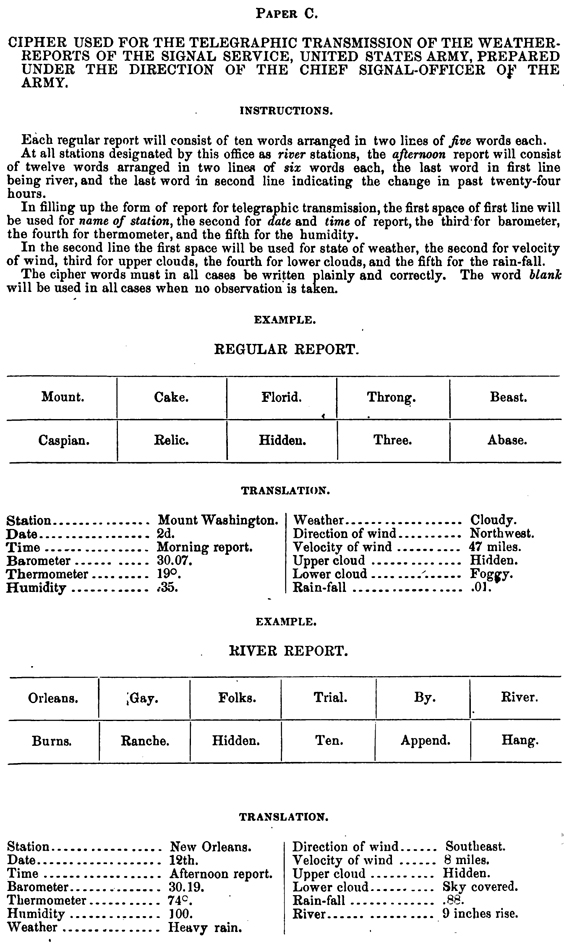
⬆
introduction and examples (cropped and combined), pages 160-170, Cipher used for the telegraphic transmission of the weather reports (1872)
BL
The river at New Orleans is not named.
| 1896
Weather Code, December 1, 1896 private collection copy/scan : link |

⬆
detail, p33 Weather Code (December 1, 1896)
This copy of the 1896 Weather Code belonged to the Lander, Wyoming station; it is soiled and in only fair condition; changes and additions are entered throughout in pencil, black and red ink, and on printed or otherwise reproduced sheets, pasted in. The code is 110 pages in length; several endpages have been removed.
Perhaps the leading feature of meteorological codes, of any era, is their sequential ordering of observations, one notation after another —
Data for transmission by telegraph will be enciphered in the following order :
- Name of station (or telegraphic designation therefor, as furnished from the central office).
- Pressure and temperature (corrected readings).
- Precipitation.
- Direction of wind, state of weather, and wet thermometer.
- Current wind velocity and minimum temperature, or current wind velocity and maximum temperature.
- Minimum or maximum temperature (in twenty-four hours) which occurred more than twelve hours previous to observation.
- Marked rise or fall of pressure (from stations specially designated).
- Report on the river observation (from stations specially designated and in certain authorized reports).
- Frost (light, heavy, or killing).
- Thunderstorms.
- Fog, haze, or smoke.
- Upper clouds.
- Lower clouds (when sent).
- Maximum wind velocity and direction (in accordance with special instructions).
- Special monthly or weekly reports.
A "Description of the code" appears on pp 8-9, followed by instructions in successive order for each of the categories of data listed above (leaving out only the straightforward abbreviations for station, e.g., Angeles for Los Angeles, Fuca for Port Angeles, Washington). <
The instructions for each category have to do with both observations and their coding. Each instruction refers implicitly to the code sections in the back of the book, that might be called "tables".
As seen in the Barometer table shown above, the Weather Code does list codewords. Yet these codewords are selected with a view to the cipher-like functions of their successive syllables. The "Description" elaborates the principles :
. . . . . . . . . . . . .
12. The code is printed in such a manner that observers may be enabled to translate the reports without using the book, provided they have made a careful examination of the key. It is a simple arrangement of consonants and vowels of the alphabet in the series of words, so as to be readily translatable at sight. (Date words and several other special lists of words which are seldom used, do not conform to the key.)
To aid the memory it should be observed that these values increase regularly, according to the order of the letters in the alphabet.
The values of the respective consonants and vowels are as follows :
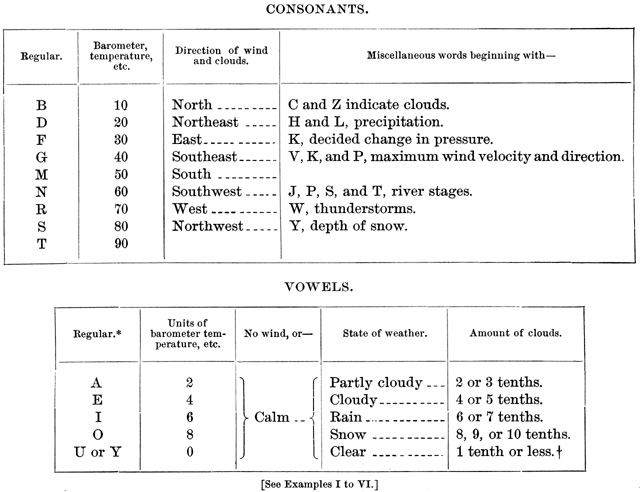
⬆
ex Weather Code (December 1, 1896)
14. In deciphering, it will be noticed that words beginning with vowels indicate that the value under consideration is less than .10, or calm, etc. In cases where the temperature, etc., is less than 10°, etc., it should be noticed that the consonant immediately preceding the second vowel is one which has no value in the code, that is, it is neither B, D, F, G, M, N, R, S, nor T, and consequently is to be ignored in translating.
One needs to see and study the "tables," in order to develop confidence that translation can be achieved without the book. It is done by meticulous, step-by-step, ergodic construction of a message.
Some stations adjusted their reports for local conditions, e.g., proximity to a major (floodprone) river. Moreover, reports from stations in cotton, sugar and rice regions, and in corn and wheat regions, forwarded their reports to section centers where, to take the example of the former case, mean maximum and minimum temperatures, and rainfall might be averaged and then sent out over regional circuits.
Six examples on pages 23-24 illustrate the use of the code in different circumstances and meeting different requirements.
- Example 1.—Regular 8 a.m. report.
- Example 2.—Regular 8 a.m. report from a river station where cirrus clouds were observed moving from an abnormal direction previous to the observation and all the precipitation occurred before 8 p.m. the previous day.
- Example 3.—Regular Tuesday morning report, in winter, from a station instructed to send snow and ice data, but that does not telegraph 8 p.m. reports.
- Example 4.—Regular 8 p.m. report.
- Example 5.—Regular 8 p.m. report for the last day of the month.
- Example 6.—Regular 8 a.m. report when there is no wind, state of weather clear, no precipitation, the minimum temperature recorded twelve hours previous was lower than at the current observation and cirro-stratus clouds were observed within one hour previous.
A separate example is given on page 22 of a coded report of "special observations," which is presented below —
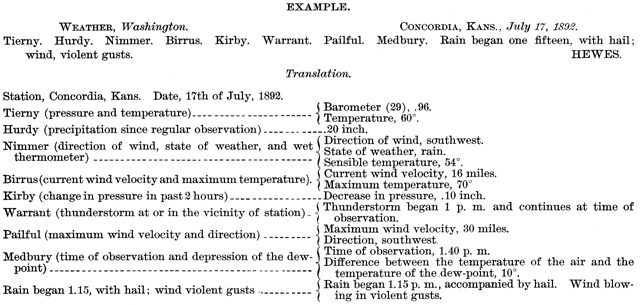
⬆
ex Weather Code (December 1, 1896)
The example is similar in format to the six examples of ordinary reports described previously. It is followed by instructions about filing and recording, including this —
137. The observer or assistant filing such messages will politely notify the telegraph manager or receiving clerk that the message is a Government message, to which priority in transmission over all private messages is secured by law; that it calls for immediate transmission; and that it is of such special importance that delay in forwarding it may result in serious public disaster.
afterword
The Weather Code was updated periodically; LC lists editions for 1913, 1924, 1931, 1939 (numeral system)*, 1942 (numeral system, possibly a wartime abridgement of the 1939 code), 1956 and 1961. To these might be added similar codes like the 1930 Aerological Code (pilot balloons), and Codes for Cloud Forms and States of the Sky according to the International System of Classification* (Weather Bureau Circular S, W.B. No. 1249., 1938). There were also codes for ship’s weather observations, and coded teletype symbol weather reports*.
* indicates codes that are now or will soon be treated in these pages.
| 1921
Radiographic weather code for vessel weather observers. NYPL copy/scan (via hathitrust) : link 31 p. incl. tables.30 cm. |
code for latitude and longitude 10-13 (one word for both)
code for pressure and temperature 14-23 (one word for both)
code for direction and force of wind and state of weather 24-25 (one word for all)
code for rise or fall of barometer in two hours previous to observation 26
code for amount, kind, and direction of clouds 26-27 (one word for all)
time words 28
followed by (non code) tables (corrections, equivalents, etc.)
An illustration message is shown below. The same message appears in the 1925 edition of this code (private collection); the codewords Royer, Beatrice and Guide do not appear in this book.
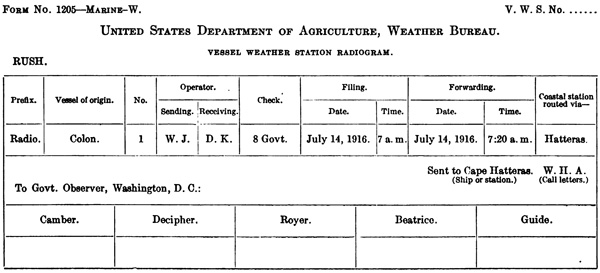
detail page 8, Radiographic weather code for vessel weather observers (1921)
| 1930
International radio weather code for use on United States selected ships. Boston Library Consortium Member Libraries), book from Marine Biological Laboratory (MBL) and Woods Hole Oceanographic Institution (WHOI) : link |
This is an early (earliest?) instance of five-figure code groups in meteorological codes. It replaces word codes, and would enventually become the norm. Pages 2 and 3 explain the “arrangements” and coding of Universal Data (covered by the first four 5F groups), and Supplemental Data (groups 5 through 7). As suggested in the example below (from page 4), one turns to tables, in successive order, for numeric codes; exceptions include latitude and longitude, which yield their own figures (with aid of some means for rendering minutes into 0-9). The codegroups, e.g., PQLLL and 111GG, are mnemonic but also signify positions to be filled by a figure 0-9.
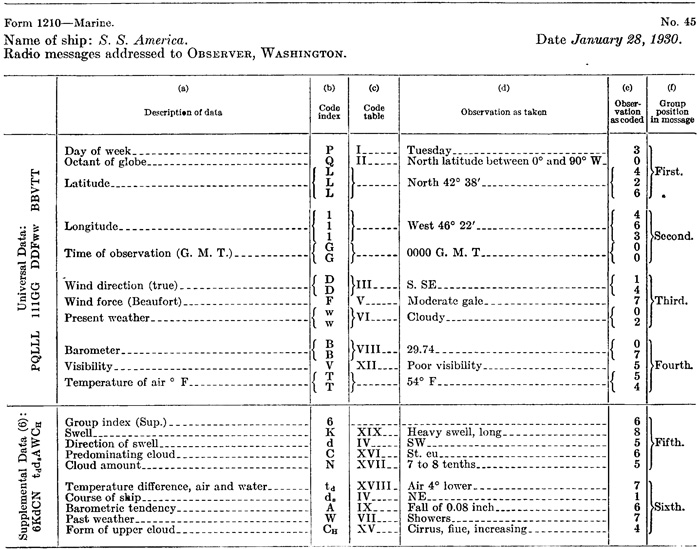
⬆
detail, page 4, International radio weather code for use on United States selected ships (1930)
| 1939
Weather Code (Numeral System) U. S. Department of Agriculture, Weather Bureau. private collection 1942 edition (in two parts), U Illinois at Urbana-Champaign copy/scan (via hathitrust) : link |
The 1939 Weather Code (Numeral System) became effective in June 1939, for use at first and second order stations of the Weather Bureau.
It replaced the Weather Code, Revised 1936 (word code), and was constructed on principles adopted by the International Meteorological Organization.
Apart from the transition from codewords to figures, the most prominent differences from the 1896 code are : increased attention to clouds (three levels rather than one) and visibility (both being of obvious interest to aeronautical users), and a much expanded network of stations.
Some limited allowance is given for use of plain language words : in connection with very high wind velocities, barometer and, precipitation, and temperature readings, and frost.
I have not been able to compare this to the 1936 edition, but gather from the heading under Examples of Coded Observations (page 19) that the 1936 edition was fundamentally the same in all but its coding method. The transition to a numeric code speaks to the increased reliability of teletype networks, over the telegraph system available in previous decades. By this time, facsimile transmission would have been available for aeronautical users, but teletype symbol weather reports continued to be used, for weather reports transmitted by the Civil Aeronautics Authority over its system of telegraph and radio facilities.
Two examples are shown below —

⬆
example 1 (p19), Weather Code, Numeral System (1939)
All observations begin with name of station, and them move methodically through tables 30 through 46.
Note in passing that the first example is for a report from Lander, Wyoming; my copy of the 1896 Code belonged to that station.
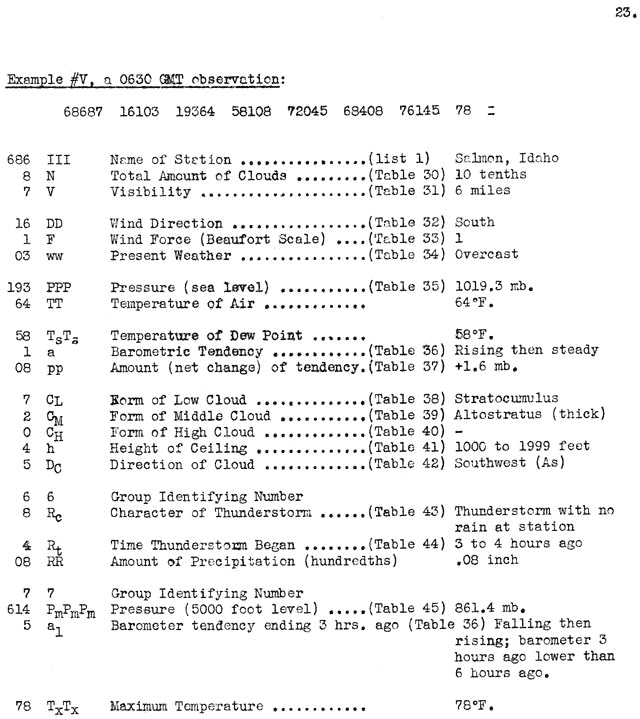
⬆
example 5 (p23), Weather Code, Numeral System (1939)
The Weather Code (Numeral System) (1939) included — in addition to identification of code groups, definition of letter symbols, descriptions of the code elements, a list of stations (with their index numbers) and the code tables, these three separate documents/sheets —
- alphabetical list of stations with international index numbers
- a map showing stations and their international index numbers for the U.S. and Canada; and
- a single large (53.5 x 42cm)
Code Tables for Weather Code, 1939
How did this work?
The Table is below. One assembles a a report by moving one-by-one through tables 30 through 36. This is essentially a figure code, position in the sequence being the crucial determinant of meaning. A report (message) might run 35 or 40 figures long, in five-figure groups. The formation of observation report No. 5 above can be traced through this code table.
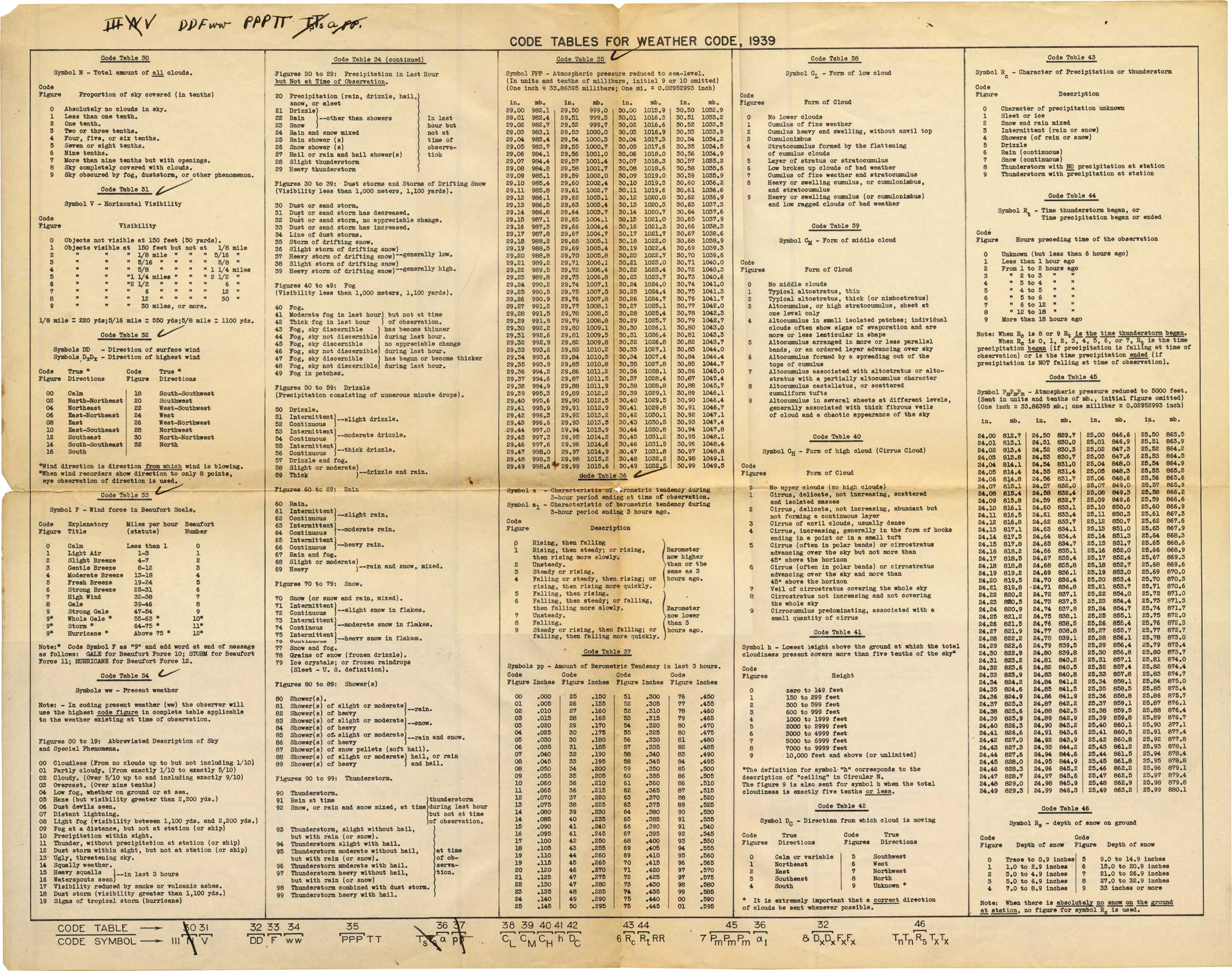
⬆
Open image in new tab for a larger view of same.
It is in the systematic assembly of information from meteorological observations, using a figure code, that we can most easily envision a transition to entirely automated reading
and filing
of data, for automated generation of synoptic reports incorporating data from many sources. The modern term for this would be telemetry.
| 1941
Instructions for airway meteorological service U. S. Department of Commerce, Weather Bureau. vii, 201 p. illus., fold. map, tables (1 fold.) diagrs. 27 cm. catalog view, hathitrust (two scans available) : link |
Coding for synoptic reports and pilot balloon observations, mainly p88-114
| 2012
Standard Hydrologic Exchange Format (SHEF) Code Manual |
It might be said that meteorological telegraphy would come to abandon human users at the level of coding and decoding, as sensor devices and processing itself became automated. SHEF is a “documented set of rules for coding of data in a form for both visual and computer recognition... designed for interagency sharing of data, visual and machine readability. It takes data fed from automated sensors — data sequence identified in a header line — and fully qualifies the data so that receiving databases have all the necessary information to describe the data.”
Vernon C. Bissell, Phillip A. Pasteris, and David G. Bennett, “Standard Hydrologic Exchange Format (SHEF),” in Journal of Water Resources Planning and Management 110:4 (Oct 1, 1984) : link (article paywalled, abstract below)
Abstract
The Standard Hydrologic Exchange Format (SHEF) has been developed jointly by the National Weather Service (NWS) and by the Corps of Engineers North Pacific Division for use in the interagency Columbia River Operational Hydromet Management System (CROHMS). SHEF features include: (1) Readability by both man and machine; (2) two characters to describe most hydrometeorological parameters; (3) internal data base identification of observational data, processed products, and forecasts; (4) time identification in either local or Greenwich meridian time systems; (5) identification of data from nonstandard locations; (6) optional special data descriptors to individual data values; (7) three different format structures to allow coding on‐station‐per‐line, several lines with common data elements indicated by a header line, and lines of evenly time spaced data strings; (8) flexibility in use of spaces and comments within code text to enhance readability; and (9) ease of use in either English or SI units. The SHEF code holds great potential for easing automated exchanges of operational hydrometeorological data among a wide variety of agencies and reducing the multiplicity of data‐receiving software typical of many broad‐scale operations.
![]()
telegraphy in meteorology
Telegraphy is woven into the literature of and on meteorology, including —
- weather reports, storm signal system
W. J. Johnston in his Telegraphic Tales and Telegraphic History (New York 1880) provides an account of telegraphic practice in the weather service.
See transcription here.
The code used naturally predated the 1880 publication of this popular book. - United States Signal Office
Ralph Abercromby (1842-1897) concluded one of his meteorological travels with an inspection of the United States Signal Office in Washington, D.C. A detailed description of the workings there can be found in his Seas and skies in many latitudes; or, Wanderings in search of weather (London 1888) : 413-21.
His account of the indications room — see transcription here — details how telegraphic reports are processed for the creation of weather maps and predictions.Information on Abercromby is not hard to find; he makes an important appearance in Richard Hamblyn's The Invention of Clouds : How an amateur meteorologist forged the language of the skies (New York 2001). The amateur that is the subject of Hamblyn's excellent book is not Abercromby but Luke Howard (1772-1864).
- T. B. Maury.
The Telegraph and the Storm : The United States Signal Service.
Harper's New Monthly Magazine 43:255 (August 1871) : 398-418 (here) - How a weather map is made
"How a weather map is made." Scientific American 82:3 (Jan 20, 1900): 38
transcription here - Friedman, Robert Marc. Appropriating the Weather : Vilhelm Bjerknes and the Construction of a Modern Meteorology (1989): 146-49, for a discussion of the post World War 1 setting in a section entitled “Weather and Forecasting Redefined.”
- James Rodger Fleming. Meteorology in America, 1800-1870 (1990)
- Australia
Federation and Meteorology : The Case of Meteorology, 1876-1908
This link leads to a passage on the realization of the importance of telegraphy to meteorology over large areas beyond particular localities.
Home, R. W. and Livingston, K. T. "Science and Technology in the Story of Australian Federation: The Case of Meteorology, 1876-1908", Historical Records of Australian Science 10:2 (December 1994): 109-27.
This is one of several articles collected together in Federation and Meterology project of the Australian Bureau of Meteorology. There is a reference to the American word-based code, which is preferred over the British Numerical Code, at page 26. - Katharine Anderson. Predicting the Weather : Victorians and the Science of Meteorology (2005)
- search results for “weather code” + “numeral system” at hathitrust : link
20231121
![]()
| 1888
The Science Observer Code UC Berkeley copy/scan (via archive.org) : link |
Pt. 1. Explanation of the number code, [by] S. C. Chandler, and J. Ritchie.
Pt. 1a. Number code, compiled by John Ritchie. 1885.
Pt.2 Phrase code, [by] S. C. Chandler, and J. Ritchie.
Pt. 3. Tables
Explanation of the Number Code details “protocols” by which a seventeen-word despatch, six-word “position message,” and a “Discovery Message” are composed; see pages 6-11.
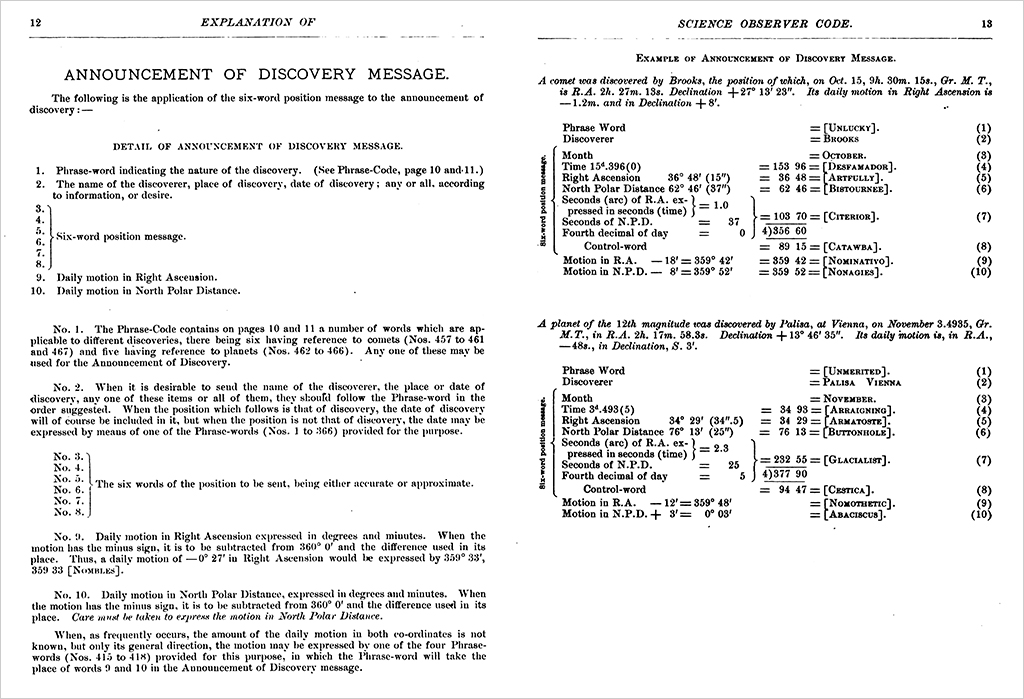
⬆
Pages 12-13, Pt. 1 Explanation, The Science Observer Code (1888)
facing pages, but borders reduced from scan
The Number Code runs from 0/00 Abaceria through 399/99 Pharicon (totalling xxx unnumbered pages).
The Phrase Code is 17 pages, providing for Date, Time, Star Catalogues, Position, Motion, Comets and Planets, Variable Stars, Sun, Spectrum, Color, Miscellaneous, Weather, Correspondence, Control Words (a check sum method), and Zero (This indicates that nothing is stated or known....
Part III Tables consists of only two pages and three tables:
“Table for reducing the decimal of a day to hours, minutes and seconds”
“Table for convering hours, minutes and seconds into decimal of a day.” and
“Table for determining the number of the day in the year.”
| 1896
Cipher Code for Astronomical Messages Edward S. Holden. Publications of the Astronomical Society of the Pacific 8:49 (April 1, 1896): 109-133. Jstor copy/scan (via archive.org) : link |
Principles of the Cipher-Code
General Rules for Astronomical Telegrams
Seventeen-Word Dispatch
Six-Word Position Message
Thirteen-Word Message
Short Index to Table IV
Phrases. Table IV. Arbitrary Cipher-Code
Table I (prefixes)
Table II (affixes)
Dates. Table III. Day of the Year
From the introduction to Table IV —
It is sometimes convenient, and it always saves expense, to have a phrase-code in which arbitrary words in the telegram stand for whole sentences in the translation. ¶ In my opinion, such tables are generally too long. ¶ The following table is essentially a copy of the “Science-Observer Code” sentences (and precepts), with different cipher-words, however. Every cipher-word belonging in this table has two syllables and six letters,; no more, no less. I have added a few needed phrases...
An appendix “Figure-Code Employed on the Continent of Europe” is not available in the JSTOR scan, but is found in the Google Books / Indiana University copy, link.
| 1906
Telegraphic Cipher Code, Gerrish System. This code earlier appeared in Edward C. Pickering, the Fifty-first Annual Report of the Director of the Astronomical Observatory of Harvard College for the year ending September 30, 1896 (1896). Harvard copy/scan (via google books) : link 15 pages |
Like many specialist codes, this one involves a step-by-step assembly of a message. One follows a set of rules — as if filling in a series of data entry fields
— and derives the code from that. Here, messages are assembled from figures, and then converted to syllables yielding the pronounceable (or euphonic,
as the expression went) codewords preferred by telegraph administrations.
Several examples are provided; one of these (taken from pages 11 and 13) is shown below:
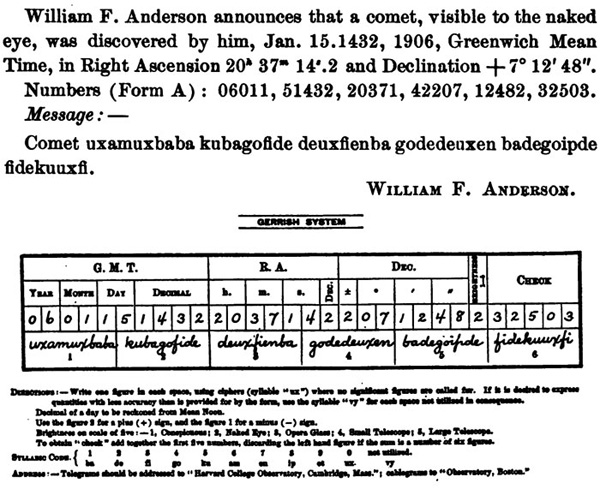
⬆
1 ba 2 de 3 fi 4 go 5 ku 6 am 7 en 8 ip 9 ot 0 ux not utilized (blank) vy
example, combined from pages 11 and 13, Telegraphic Cipher Code, Gerrish System (1906)
![]()
1936 to present
- 1936
Elis Strömgren.Cipher Code for Astronomical Telegrams, accepted at the International Astronomical Union at the Paris Meeting July 1935, to be used from 1935 November 1.
in Transactions of the IAU, Vol. 5 (Fifth General Assembly, Paris, July 10-17, 1935) : 391-396
[figure code, plus occasional words (for names, nature of the object, possibly involving use of numbered codewords although this is not specified. provides for several types of communication :
(1) communication of discovery of comet or planet; (2) communication of an observed position; (3) communication of other discoveries and observations; (4) communication of parabolic and nearly parabolic orbits; (5) communication of elliptic elements of comets and planets; (6) communication of a circular orbit; and (7) communication of an ephemeris. - 1955
Julie Vinter Hansen.The International Astronomical News Service.
in Arthur Beer, ed., Vistas in Astronomy, Vol 1. New York: Pergamon Press, 1955 : 16-21
available here
excellent summary of early years: astronomical cablegrams underwritten by theAssociated Trans-Atlantic Cable Companies
(1873); first code being Chandler and Ritchie, which (in its earlier manifestation) was imperfect (see p 19), and so another code was proposed by Krueger (1882), based on Karlinski (1866). see Astronomische Nachrichten 1866, 66:1562 and 1882, 104:2481).
nice passage p 21 on clerical work of decoding and rewriting, which is far easier thanthe deliberations before it is decided to transmit a message.
also, observation that a free service (1873) occasioned moral hazard :[Förster ] considered the telegraphic transmission of astronomical news free of charge a doubtful blessing, because experience showed that people when not having to pay were apt to be too hasty in transmitting their supposed discoveries without checking them carefully. He also wished for a telegraphic code that would permit immediate check on the cabled figures.
- 1966
Owen Gingerich.The Central Bureau for Astronomical Telegrams.
In J.-C. Pecker, ed., Astronomer’s Handbook (Transactions of the International Astronomical Union, vol XIIC; 1966) : 32-38
coins the wordastrograms
(33). subscribers can specify the type of telegram they wish to receive (collect charge) , from 8 different categories. Appendix 1 provides the code, Appendix 2Telegram code for comet position
similar to the Gerrish tables. - 1970
Brian G. Marsden (1937-2010 *).The Central Bureau for Astronomical Telegrams.
Astronomical Society of the Pacific, Leaflet No. 493 (July 1970): 1-8
on reports of discoveries of comets, novae, supernovae
note —
Brian Marsden kindly walked me (literally, in the Wolbach Library) through all of the recent literature on astronomical codes, and reminisced about the last one received, some years before. - 1981
Astronomical Telegram Code,
in report of The Central Bureau for Astronomical Telegrams, IAU Information Bulletin 46 (June 1981) : 11-16 - History of the Central Bureau for Astronomical Telegrams
*
20150803 / 20231113